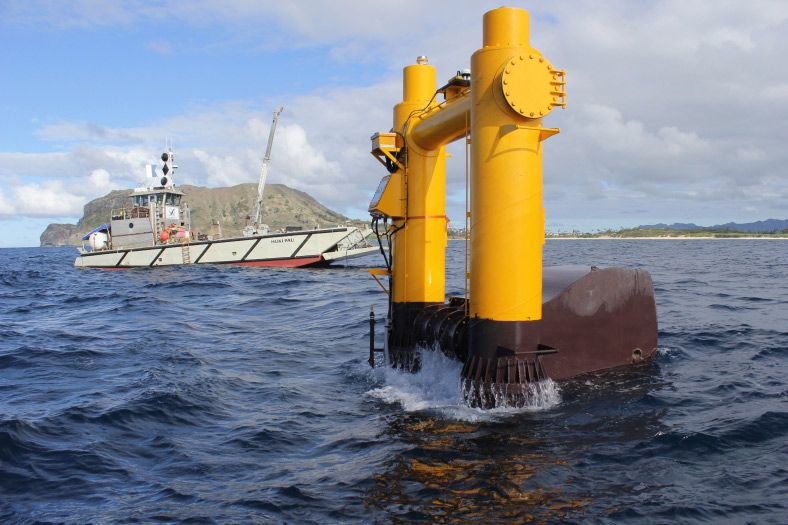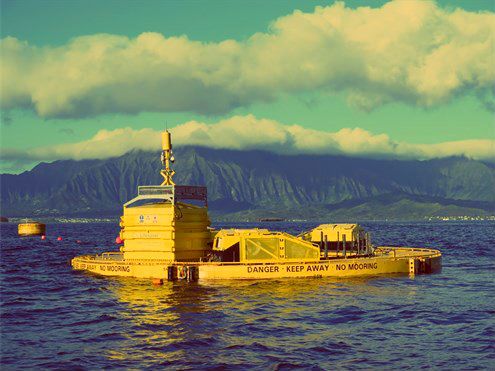America's First Wave-Produced Power Goes Online in Hawaii
Published on by Water Network Research, Official research team of The Water Network in Technology
There are two buoys in Hawaii that use waves to generate electricity - one uses the up-and-down motion of the waves, while the other exploits the side-to-side movement.
The current travels through an undersea cable for a mile to a military base, where it feeds into Oahu's power grid — the first wave-produced electricity to go online in the U.S.
 By some estimates, the ocean's endless motion packs enough power to meet a quarter of America's energy needs and dramatically reduce the nation's reliance on oil, gas and coal.
By some estimates, the ocean's endless motion packs enough power to meet a quarter of America's energy needs and dramatically reduce the nation's reliance on oil, gas and coal.
But wave energy technology lags well behind wind and solar power, with important technical hurdles still to be overcome.
To that end, the Navy has established a test site in Hawaii, with hopes the technology can someday be used to produce clean, renewable power for offshore fueling stations for the fleet and provide electricity to coastal communities in fuel-starved places around the world.
Hawaii would seem a natural site for such technology. As any surfer can tell you, it is blessed with powerful waves. The island state also has the nation's highest electricity costs — largely because of its heavy reliance on oil delivered by sea — and has a legislative mandate to get 100 percent of its energy from renewables by 2045.
Still, it could be five to 10 years before wave energy technology can provide an affordable alternative to fossil fuels, experts say.
For one thing, developers are still working to come up with the best design. Some buoys capture the up-and-down motion of the waves, while others exploit the side-to-side movement. Industry experts say a machine that uses all the ocean's movements is most likely to succeed.
Also, the machinery has to be able to withstand powerful storms, the constant pounding of the seas and the corrosive effects of saltwater.
The United States could get 20 to 28 percent of its energy needs from waves without encroaching on sensitive waters such as marine preserves.
Though small in scale, the test project near Kaneohe Bay represents the vanguard of U.S. wave energy development. It consists of two buoys anchored a half-mile to a mile offshore.
 The buoy named Azura, which extends 12 feet above the surface and 50 feet below, converts the waves' vertical and horizontal movements into up to 18 kilowatts of electricity, enough for about a dozen homes. The company working with the Navy, Northwest Energy Innovations of Portland, Oregon, plans a version that can generate at least 500 kilowatts, or enough to power hundreds of homes.
The buoy named Azura, which extends 12 feet above the surface and 50 feet below, converts the waves' vertical and horizontal movements into up to 18 kilowatts of electricity, enough for about a dozen homes. The company working with the Navy, Northwest Energy Innovations of Portland, Oregon, plans a version that can generate at least 500 kilowatts, or enough to power hundreds of homes.
 A Norwegian company developed the other buoy, a 50-foot-wide, doughnut-shaped device called the Lifesaver. Cables anchor the 3-foot-tall ring to the ocean floor. When the sea wobbles the buoy, the cables move, turning a generator's wheels. It produces an average of 4 kilowatts.
A Norwegian company developed the other buoy, a 50-foot-wide, doughnut-shaped device called the Lifesaver. Cables anchor the 3-foot-tall ring to the ocean floor. When the sea wobbles the buoy, the cables move, turning a generator's wheels. It produces an average of 4 kilowatts.
The Hawaii buoys are barely noticeable from shore, but developers envision dozens of machines working at once, an idea that could run into the same opposition wind turbines have faced from environmentalists, tourist groups and others.
Source: abc News
Media
Taxonomy
- Energy
- Wave & Tidal Energy
- Wave Energy
- Wave & Tidal Energy
- Water